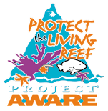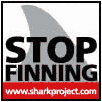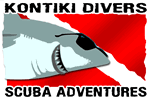Join me on a dive in Pescador Island!
By Karl H. Epp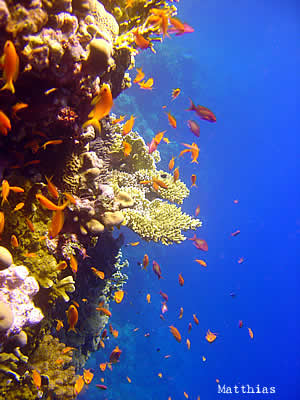 Many people ask me how it is to dive. How is a typical dive done? What do you see? How do you feel? So join me on a typical dive in Pescador Island, the famous Marine Park in Moalboal, Cebu.
Many people ask me how it is to dive. How is a typical dive done? What do you see? How do you feel? So join me on a typical dive in Pescador Island, the famous Marine Park in Moalboal, Cebu.
Our dive is scheduled for 10:00 am. About 9:30 we meet in the dive center, assemble the dive equipment, get the equipment to the boat. A few divers will join us on our morning dive.
After a ten-minute ride we reach Pescador Island and the boat ties up on one of the buoys the environmental conscious dive centers in Moalboal put up there. You and me pair up as a buddy team, because in Sport Scuba Diving you never dive alone. Your buddy is there to assist you in case something goes wrong and to share the fun and experience with you. First we evaluate the environmental conditions. The weather is just fine, bright sunshine, no wind, no waves. On a beautiful summer day like this it is almost like there is no water if you look down the side of the boat. You can see already the colorful coral gardens and teeming fish standing in a slight current and you long to jump in right away.
But first we do the briefing: This should be a deep dive, as we have trained in the PADI Advanced Open Water Course. Because we make our dive along a steep wall, we plan to make a multilevel dive starting at a depth of 35m. There is a special point where we have a good chance to see White Tip sharks. After 6 minutes we ascend to a depth of 20m. We will stay there for another 20 minutes and then ascend to 5-6m, where we spend the rest of the time of our dive and make a safety stop to get rid of excess nitrogen in a safe way. Now we do a buddy check, means that we check out each other’s equipment: buoyancy jacket - ok, weight belt - ok, releases - ok, air - ok, and final ok. All right, we are ready to go. We sit opposite each other in our small banca, with our backs to t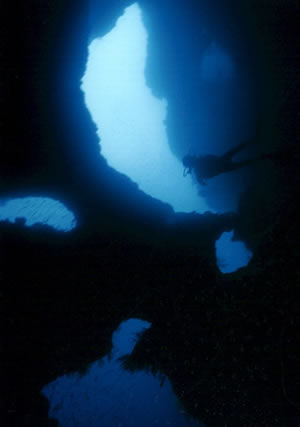 he sea. I count:” Ready… Set .. Go!” and we let go.
he sea. I count:” Ready… Set .. Go!” and we let go.
We are falling backwards and with a big splash we enter the deep blue water, bobbing back up to surface right away because of the air in our Buoyancy Jackets. We swim to the buoy line, release some air out of our jackets and start our descent along the line. The magic blue environment swallows us.
You can not talk, but there are many sounds: the hissing of the valves in your scuba unit, the air bubbles your exhaling fleeing to surface, the current and waves moving small particles in the reef, the sound made by colorful parrot fish when they eat hard corals. Over the drop off you glide to the bottomless void. You are descending deeper and deeper, watching your depth gauge and your buddy, equalizing the pressure in your ears.
At 30 m we start to slow down, at 34m we stop our descend. The underwater world is different now. There are not so many colors anymore, and it’s darker than close to the surface. We drift slowly with the current. Sometimes we stop, looking in small caves for murray eels, big groupers, or, if we have some luck, for a sleeping White Tip shark.
Suddenly I hear a sound behind me. You bang your diving knife against your tank, a diver’s way to gain attention from your buddy. I turn around to look at you. You are right behind me, where you should be, eyes wide open, pointing out in the blue. I look where you are pointing at and I see a school of big barracudas very close to us. Four, no five of them, each of them at least a meter big. They stand motionless in the current, holding their position without any visible effort. They seem to observe us with cold, merciless eyes, like if we would fit for a midmorning snack. They are joining us for four, five minutes, keeping always the same distance to us. According to our dive plan we have to ascend to a shallower depth now, and the barracudas disappear in the big blue.
We continue our dive, gliding weightless along the wall, stopping here and there, exploring the colorful reef, finding many different kind of reef fish, like lion fish, bat fish, sea cucumbers and so on. At the end of the dive we encounter a sea snake. Another potentially dangerous animal, very poisonous but not aggressive. We just keep a little distance and observe the snake hunting in the reef: how it glides from hole to hole, looking for her prey. After a while the snake runs out of air and it glides in smooth, wavelike movements up to surface, gets some fresh air, and heads down again.
Time is flying by and soon we are low of air, too. We have to ascend and to get back to the dive center. We are really happy, chatting in the boat with the other divers about all the things we have seen. Okay, we missed the sharks, but this gives us just an excuse to go back there again. And these barracudas …, man, they were really cool! We quickly agree to join also the afternoon dive.




